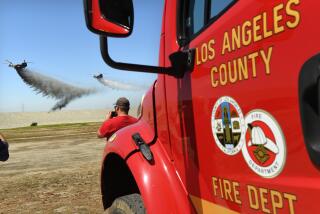County to Award Ambulance Pacts After 2 Years of Lobbying
Two years ago, as Los Angeles County’s emergency transportation contracts were set to expire, ambulance companies girded to compete for the exclusive right to deliver the county’s sickest and most seriously injured patients to hospitals.
They hired lobbyists. They donated thousands of dollars to politicians. And they sought support from officials in dozens of small cities throughout the county. What was supposed to be a six-month process dragged on as the county’s Department of Health Services tried to develop objective criteria for recommending who should get the lucrative contracts, which last for 10 years.
Now, with the five-member Board of Supervisors scheduled to consider today who should get those contracts, several ambulance companies are in the final stage of a ferocious behind-the-scenes campaign to secure the needed majority of votes.
Lobbying for county business is hardly unique to this set of contracts. Supervisors’ campaign treasuries are filled with donations from developers, contractors and others seeking to benefit from county regulation or grants. Lobbyists do a rich business helping clients gain access to press their cases with influential bureaucrats and supervisors.
But the companies that win the ambulance contacts will be responsible for providing a singularly vital service, one of the most important that the supervisors oversee, and the companies’ performance will touch the lives of thousands of residents in the nation’s most populous county. Every year, county-authorized ambulances rush about 150,000 people to local hospitals, their response time often determining who lives and who dies.
For some healthcare experts, the attempt to influence the ambulance contracts underscores how business frequently is done at the county level, where even issues that involve critical medical decisions become political.
“We’re not talking about widgets here. We’re not talking office contracts. We’re talking about life-and-death situations,” said Jim Lott, executive vice president of the Hospital Assn. of Southern California, which represents hundreds of hospitals that will treat patients delivered by the winning bidders.
Two dozen cities in the county, including Los Angeles and Long Beach, operate their own ambulance services or hire private companies to do the job. The rest -- including unincorporated areas and 62 cities that stretch from Cerritos to Lancaster -- look to the county to decide who will provide emergency medical transportation in their areas. The territory is so vast that the county divides it into seven zones and awards exclusive contracts for each.
American Medical Response currently has the rights to operate in the vast majority of county-controlled areas, with two other companies holding contracts for relatively small territories.
Bidder David Mintz, a national vice president at American Medical Response, contends that one reason the process has become politicized is that health officials failed to properly evaluate the firms.
“Ultimately and theoretically, it should not be a political decision. The reality is that you know that is how decisions are made,” Mintz said. “We’re just going to continue to work the board offices, give them facts as we know it, encourage them to find out for themselves, encourage them to talk to their communities and make a decision.”
The private ambulances respond to 911 calls with two employees trained to provide basic lifesaving services if they arrive before fire department paramedics, who are trained to give more advanced care. Once patients are stabilized, private ambulances drive them to the nearest available hospital.
Ambulance companies make money by billing patients or their health insurance providers. The firms are not required to disclose how much profit they expect, but county officials said they believe the deals are highly profitable. It is not uncommon for companies to charge $700 or more to treat and transport the seriously ill.
“It’s lucrative,” said Carol Meyer, who oversees the evaluation of bids as the county’s director of emergency medical services.
Offsetting some profits is a county requirement that ambulance firms pick up the tab for patients who cannot pay.
As the Health Services Department began soliciting bids on new contracts in May 2004, officials recruited five experts on emergency medical services to evaluate the proposals. Together, Meyer said, the panel brought to the task more than 125 years of experience.
Nine companies submitted bids. But the inches-thick glossy binders that arrived at the Health Services Department contained more than just dry statistics on such criteria as ambulance maintenance, response times, cost to patients and employee training. The bids were evaluated to determine such things as which companies offered the fastest response times and greatest financial stability.
Other, less quantifiable, factors also entered into the equation. In many communities, ambulance companies cement ties with a good bedside manner, donating vehicles, appearing at local events and in some cases teaching schoolchildren about medical safety. The bids included dozens of letters signed by local officials endorsing one company or another.
“As city manager,” wrote Ken Pulskamp in Santa Clarita, “I ... feel it would be a great loss to us and the surrounding communities if AMR [American Medical Response] was not permitted to continue to provide emergency services.”
American Medical Response, determined to get its message to the supervisors, hired two lobbying firms, for which it paid $120,000 a year.
Anaheim-based Care Ambulance Service Inc., meanwhile, had hired its own lobbyist at the end of 2003 and added a second a year later.
“We run an ambulance company, and we know ambulances, but when it gets to the political process, we have a consultant,” said Rick Richardson, who runs the company with his brother Dan.
By the end of 2004, three more firms had armed themselves with lobbyists. In all, county records show, the companies have spent $491,000 on lobbying for the contracts in the last two years.
Those same firms also dug deep into their pockets to help each of the five Los Angeles County supervisors, donating more than $45,000 combined to their campaign and officeholder committees in the last two years.
When asked about the donations, supervisors said they would not allow such support to influence their decisions on awarding contracts. Yvonne Brathwaite Burke, who received $18,000 from ambulance firms, noted that the contributions came from five ambulance providers.
“I don’t think that most of us look at who has given more or less when we evaluate a contract,” she said, adding that she saw no reason to turn down donations from companies with business before the county. “If [contractors] feel that ... they want to have some influence as to who represents them, that’s a determination that that contractor can make.”
In September 2004, the Health Services Department announced its recommended choices: four of the nine companies.
The news set off a flurry of protests from the other ambulance firms. Lobbyists wrote to the supervisors. So did local elected officials. American Medical Response was particularly active. Under the staff recommendations, it was both a winner and a loser -- it secured the recommendation for more of the contracts than any other company but also, because it had controlled more of the area initially, would lose more business than any other.
The California Contract Cities Assn., which represents more than 50 cities in Los Angeles County, weighed in. The association urged supervisors to pick American Medical Response for all seven zones, not just the four that experts recommended.
Competitors and their lobbyists -- including Schaefer Ambulance Service and Westmed/McCormick Ambulance Service -- urged supervisors to rely on the bidding process rather than on local politicians.
Some protests focused on how the county had evaluated the bids. American Medical Response argued that the examination of response times -- how fast ambulances arrive at a patient’s side -- was flawed. An appeals board made up of county administrators agreed and recommended that the Health Services Department make changes.
The department accepted some changes but rejected others. Its final recommendations to supervisors left American Medical Response with three zones, Westmed/McCormick with two and Schaefer and Care with one apiece.
In the last two weeks, the firms have stepped up the pressure on the county.
Today’s discussion by the supervisors marks the latest milestone in that debate. And as it has approached, lobbyists have taken to wandering the eighth floor of the county’s Hall of Administration in downtown Los Angeles, buttonholing supervisors’ aides to make their arguments.
It is, one aide offered, a case of “drive-by lobbying.”
More to Read
Get the L.A. Times Politics newsletter
Deeply reported insights into legislation, politics and policy from Sacramento, Washington and beyond. In your inbox three times per week.
You may occasionally receive promotional content from the Los Angeles Times.











